 |

|

|

|

|

|

|

|

|
DR. NO, the first of the "James Bond" film series, was a dazzling adventure that would change the 'look' of action films, forever. While the film's 'plot' would become 'Standard Bond' (a maniac attempts to 'heat up' the cold war by provoking America, in this instance, by crashing it's rockets), and reappear in many incarnations over the years, the story behind the first film is still fascinating.
From the completion of his first 007 novel, "Casino Royale", in 1952, 41-year old author Ian Fleming believed that movies and television would be the best 'forum' for James Bond. But deals usually fell through (one that didn't, resulting in an American TV adaptation of "Casino Royale", in 1954, was a flop), and failed screenplays would be rewritten into best-selling short stories and novels, instead. Not surprisingly, the novels impressed many film producers with their cinematic sweep and potential. Two of the producers, American Albert (Cubby) Broccoli, and Canadian Harry Saltzman, would become the key players in bringing DR. NO to the screen.
Saltzman had managed to obtain an option to most of Fleming's work, but the move left him too financially strapped to produce them. Broccoli had wanted to produce the Bond novels, himself, but didn't own the rights. When Saltzman refused to sell, but offered a partnership, instead, Eon ("Everything Or Nothing") Productions was created, and United Artists, impressed by both men's enthusiasm and vision, agreed to bankroll their proposed "Bond" series. DR. NO was chosen as the first feature to be filmed, with a budget of only one million dollars (a small sum, even in 1962), and, after several directors (including future Bond legend Guy Hamilton) passed on the project, Terence Young, as smoothly elegant as 007, himself, signed.
Who would play James Bond? Fleming jokingly suggested 52-year old star David Niven (who would, in fact, later play Bond in the spoof, CASINO ROYALE). Screen legend Cary Grant, 58, whose Hitchcock-directed spy adventure, NORTH BY NORTHWEST, would be homaged in FROM RUSSIA WITH LOVE, was approached by Saltzman, but Grant would only agree to make one film, not a '007' series, and he demanded a salary that would have wiped out most of the production budget! Broccoli favored Roger Moore, 34, but he was unavailable, under contract for "The Saint" television series. Then, independently of each other, both Broccoli and Saltzman heard about Scottish actor Sean Connery, 31. After viewing DARBY O'GILL AND THE LITTLE PEOPLE, Broccoli arranged an interview, was greatly impressed ("Sean moved like a sexy, dangerous cat"), and hired the actor, assigning director Young to 'smooth out' Connery's 'rough edges', replacing them with style and sophistication. Connery was a quick learner, and soon was so impressive that even Ian Fleming would call him perfect, and would, in fact, incorporate elements of Connery into the Bond of the novels.
Veteran stage and screen character actor Joseph Wiseman, 44, was chosen as Dr. No, after Noel Coward refused the role ("Dr. No? No! No! No!"), and Fleming cousin, actor Christopher Lee, had scheduling conflicts. Future "Hawaii 5-0" star Jack Lord, 42, a prot�g� of longtime Broccoli friend Gary Cooper, was cast as C.I.A. agent Felix Leiter, and Swiss bombshell Ursula Andress, 26, became Honey Ryder, Bond's first leading lady (her voice dubbed, because of her thick accent). With Bond 'regulars' "M" (Bernard Lee) and Miss Moneypenny (Lois Maxwell) in place, the Bond legend began.
A few bits of trivia: the 'gunbarrel' introduction, created by 'Opening Credits' designer Maurice Binder, featured stunt 'double' Bob Simmons, rather than Connery, as it was added after shooting was wrapped; Ken Adam's futuristic sets would not only become Bond highlights, but would influence 'real' interior design styles for a generation; and the film's score was by London theatrical composer Monty Norman, with John Barry's participation consisting of conducting the orchestra, and orchestrating Norman's "James Bond Theme"...which Barry did so well that he would become THE Bond composer for over twenty years!
DR. NO was a hit, particularly in Great Britain, and it received a HUGE boost in the U.S. when it was discovered President Kennedy was a 007 fan (FROM RUSSIA WITH LOVE was chosen as the second film, in part, because it was a favorite novel of JFK). While the film lacked the 'overabundance' of gadgets and style elements of the later Bond entries, it was a remarkable debut!
And James Bond WOULD return...

|

|
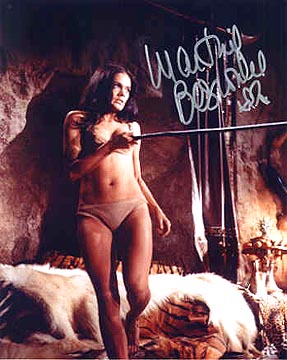
|

|
If DR. NO provided the framework for what would become the 'James Bond' series, FROM RUSSIA WITH LOVE would introduce the style, with a pre-title action sequence, worldwide settings, intense, occasionally 'over-the-top' action sequences, carnivorous (if G-rated) sexuality between bedsheets, nifty gadgets by Q (as portrayed by Desmond Llewelyn, in his first 'Bond' appearance), and a 007 who would be even more sophisticated than in the first film. Brilliant director Terence Young, as stylish and worldly as Ian Fleming's secret agent, left an indelible stamp with FRWL that has influenced every subsequent 'Bond' film, and, for many fans, this production IS the best 007 film, ever.
When, during the production of DR. NO, it was revealed that "From Russia With Love" was one of President John F. Kennedy's favorite novels, producers Albert Broccoli and Harry Saltzman quickly decided it would be the follow-up film, and brought in Johanna Harwood and Richard Maibaum to produce a script. Utilizing SPECTRE as the villains, rather than the dated Soviet spy network, SMERSH (and thus introducing mastermind Ernst Blofeld, unseen but ever-present), the story became an elaborate tale of the worldwide terrorist network discrediting both the British and Soviet intelligence networks, thus gaining dominance.
For the roles of the villains, Young cast consummate British actor/playwright Robert Shaw, 36 (12 years before his most famous portrayal, shark hunter "Quint", in JAWS), as assassin Red Grant, and the legendary German star, Lotte Lenya, 64, widow of brilliant German dramatist Kurt Weill, as frog-like ex-KGB agent Rosa Klebb. Coercing a beautiful Soviet army officer (Italian beauty pageant winner Daniela Bianchi, 21) into pretending to 'love' 007, and offering the British a secret Lector (coding device) if Bond will come to Istanbul to retrieve it, Klebb, showing a lesbian lust for the girl, plans to shoot film of their tryst, then execute the pair, keeping the Lector for SPECTRE, and releasing the film to create an international scandal.
Director John Ford offered veteran star Pedro Armend�riz' services to director Young, and the popular Mexican actor was cast as Bond's Turkish contact, Kerim Bey...but halfway through the filming, it was discovered that 51-year-old Armend�riz was dying of cancer, and his scenes had to be quickly finished. Shortly afterwards, he committed suicide, rather than face lengthy, expensive cancer treatment. His scenes with Connery are film highlights.
With one sequence set onboard the famous 'Orient Express' (a location Connery would appear in again, in 1974's MURDER ON THE ORIENT EXPRESS), which would culminate in the famous Grant/Bond brawl to the death, another action scene, of Bond attacked by a helicopter (in homage to NORTH BY NORTHWEST), and a climactic high-speed boat chase, FRWL successfully balanced both a suspenseful plot and terrific action. Connery, complete with a new hairpiece and trimmed eyebrows, under Young's careful tutelage, became the epitome of 'cool' as 007, the last of the 'rough edges' evident in DR. NO smoothed out. He was superb in the role, giving what many feel was his best performance as 007.
FROM RUSSIA WITH LOVE was a HUGE hit, and paved the way for the biggest 'Bond' of all, GOLDFINGER, and the beginning of the 007 craze...

|

|

|
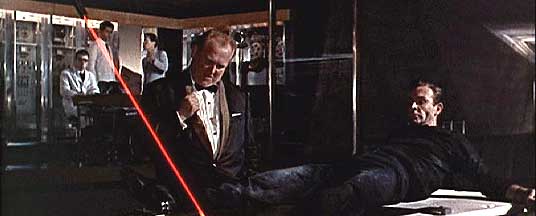
|
Over forty years after it's initial release, the third 'James Bond' film, GOLDFINGER, remains the quintessential 007 film for many fans, with a level of hysteria upon it's initial release that younger fans may not fully appreciate. It set records at that time as the fastest-grossing film in history (making back it's $3,000,000 production cost in a mere 2 weeks, on only 67 screens), spawned the first massive 007 merchandising 'blitz' (with everything from jigsaw puzzles, dolls, and lunchboxes, to shoes and cologne, and even Aston Martin DB5 automobiles offered as 'collectibles'), launched a whole new genre of 'spy thrillers' to TV and film (with the debut of the Ian Fleming-approved TV series, "The Man from U.N.C.L.E." in America, and the increased popularity "Danger Man" and "The Avengers" would enjoy in Britain), and gave the franchise it's first worldwide #1 hit song, sung by Shirley Bassey. Everyone was crazy about 007, with a resulting pandemonium that rivaled the adoration of the Beatles in it's intensity!
The story, pitting the British secret agent against a megalomaniac whose master plan was to explode a 'dirty' nuclear device at Fort Knox, thus poisoning the American gold supply, and making his own gold reserves infinitely more valuable, would benefit from 'perfect' casting. German actor Gert Frobe, 51 (his voice dubbed, as he barely spoke English), was an ideal Goldfinger, a rotund, piggish monster who always 'cheated' to win, at cards, golf, or dealing with adversaries. His 'right-hand man', Oddjob, played by Hawaiian wrestler Harold Sakata, 43, became the prototype of every subsequent villainous henchman; silent, nearly invulnerable, with an evil grin and a steel-edged bowler hat he would toss that could cut the head off a marble statue, or dispatch an innocent girl.
Bond's women were never sexier; Shirley Eaton, 27, created a sensation in a 5-minute appearance as 'Jill Masterson', who betrays Goldfinger for a tryst with 007, and ends up a nude corpse covered in gold paint; and 27-year old "Avengers" alumni Honor Blackman, as the lesbian pilot 'Pussy Galore' (yes, the name DID cause problems with American censors), who discovers the joys of male lovers after Bond pins her in a fight. Sean Connery, at 34, was simply irresistible in his third outing as 007!
Director Guy Hamilton, making his first Bond movie, said that the character of 007 only needed a 'push' to become a Superman, and he provided it, by increasing the humor and ever-present gadgets, most memorably the prototype Aston Martin DB5, complete with armor plating, machine-gun turrets, rotating license plates, and an ejector seat.
Unforgettable moments abound, from the "shocking" pre-title sequence, to the golf match between Goldfinger and Bond (introducing Connery to the sport that would become his lifelong passion), to the famous laser torture scene ("Do you expect me to talk?" "No, Mr. Bond, I expect you to DIE!"), to the climactic fight between Bond and Oddjob (during which Connery was actually injured, and Sakata burned his hand, badly).
007 author Ian Fleming passed away during production, after a last visit to the Pinewood set (although the story takes place in Florida, Switzerland, and Kentucky, nearly all of the film was shot in England). He was very pleased at the success his creation had achieved, thus far, thought Connery made an ideal Bond, and was confident in the future of the series, in the hands of producers Albert Broccoli and Harry Saltzman.
And speaking of the future...A few months later, in Ireland, twelve-year old Pierce Brosnan would view GOLDFINGER (the first Bond film he'd ever seen), and decide to become an actor, fantasizing about playing the spy, someday...

|

|

|

|

|

|

|

|
With THUNDERBALL, the worldwide James Bond craze reached levels of insanity never achieved by any other film series. With theaters staying open 24 hours a day to packed houses, Sean Connery's face on the cover of every major American and European magazine, literally hundreds of promotional tie-ins with other products, and dozens of 'copycat' film and television series cashing in on the 007 formula, the sheer magnitude of James Bond's popularity was astonishing. And, despite overlong underwater sequences, and a growing reliance on gadgets over plot, the film still gave fans what they wanted; adventure on a massive scale, breathtaking women, and Sean Connery, 35, more 'cool' and dangerous than ever.
Producers Albert Broccoli and Harry Saltzman had intended THUNDERBALL as the first James Bond film, but when filmmaker Kevin McClory took author Ian Fleming to court (Fleming's novel had been based on an unproduced screenplay written by Fleming, McClory, and Jack Whittingham), the producers opted for DR. NO, instead. With the case settled in 1964, THUNDERBALL was chosen as the follow-up to GOLDFINGER, with McClory, as part of the settlement, given a 'Producer' credit, along with limited 'permission' to create his own Bond film (which, after nearly 20 years of legal battles with MGM/UA, would result in NEVER SAY NEVER AGAIN, a 'remake' of THUNDERBALL, again starring Sean Connery). GOLDFINGER director Guy Hamilton, pleading exhaustion, bowed out of the film, but the series' first director, Terence Young, who had 'created' the James Bond 'look', was available, bringing his own distinctive style to the mix.
The plot involves SPECTRE's crashing a NATO bomber, and stealing two nuclear missiles, with which they blackmail the world. James Bond, recuperating at a 'health farm' after the events of the pre-credits sequence (where he fights the 'widow' of an enemy agent, revealed to be the agent, himself), is already an unwitting adversary in SPECTRE's plot (as the 'double' of the NATO pilot is recovering from plastic surgery at the same clinic, prior to piloting the bomber, and incurs 007's 'displeasure'). Soon Bond is in the Bahamas, facing villain Emilio Largo (Italian actor Adolfo Celi, 43), his sexy 'hit' woman, Fiona Volpe (sexy Italian Luciana Paluzzi, 28), and the actual NATO pilot's sister, Largo's mistress, Domino (breathtaking ex-Miss France Claudine Auger, 23). While humiliating Largo at cards and skeet shooting, Bond reveals to Domino that Largo and Volpe had murdered her brother, thus enlisting her aid. Despite numerous attempts to kill 007 (including a shark sequence where Connery actually came 'face-to-face' with a man-eater, accidentally..."Not an experience I'd care to repeat," Connery quipped), he unravels the SPECTRE plot, resulting in a long, climactic undersea battle, and final brawl aboard Largo's out-of-control yacht.
Despite Sean Connery's claim that THUNDERBALL was his favorite Bond film, he was clearly 'burning out' during the production. The hundreds of reporters on location gave him little privacy, while the physical demands of the role drained his energy. Despite making MARNIE (for Alfred Hitchcock), WOMAN OF STRAW, and THE HILL, he felt that no one took his 'non-Bond' performances seriously, and that Albert Broccoli had not treated him fairly in splitting the huge profits of DR. NO and FROM RUSSIA WITH LOVE, creating an animosity that would last for years. He refused to attend any of the many premieres of THUNDERBALL, and would soon announce that the next Bond film would be his last.
The James Bond franchise had achieved the pinnacle of success...It now had nowhere to go, but down...

|

|
|

|
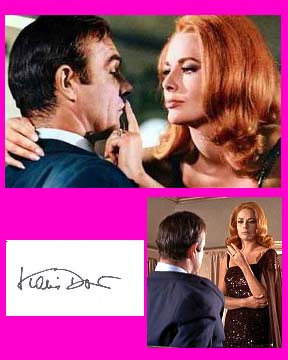
|

|
YOU ONLY LIVE TWICE, follow-up to the most successful 007 film of the franchise, THUNDERBALL, was the end result of Eon Productions' decision to take advantage of Japan's nearly fanatical love of 'James Bond', and their desire to bring him to their country for the next 007 adventure. Although ON HER MAJESTY'S SECRET SERVICE, to be shot primarily in Switzerland, had been planned, the Japanese offer was too good to pass up, so Sean Connery, instead of appearing in the most ambitious and dramatic Bond story ever made, would make his first 'farewell' appearance in the weakest, most far-fetched 007 story, yet...just as the James Bond 'craze' was beginning to subside.
Ian Fleming's novel, written as his health was failing (only one more Bond novel would appear, THE MAN WITH THE GOLDEN GUN, published posthumously), was more introspective than his previous works, with Bond facing a mental breakdown, his apparent death, and fatherhood for the first time, and would have been nearly impossible to film. So Albert Broccoli and Harry Saltzman brought in legendary author Roald Dahl ("Willy Wonka & the Chocolate Factory") to create a story, retaining only the title and character names from the Fleming work. Dahl's 'take', while providing lovely views of Japanese culture and folklore, science fiction elements, and a huge climactic battle, revealed an embarrassingly obvious lack of knowledge of 007 lore (at one point, Henderson, Bond's British Intelligence contact in Tokyo, who should be fluent of all of Bond's habits, brings him a martini "stirred, not shaken"), and an array of ridiculous, even embarrassing sequences, such as when the hirsute, 6'2" Connery is 'disguised' to pass as a Japanese fisherman, so outrageous that they teeter precariously close to being 'camp'.
As the film's villain, Ernst Stavro Blofeld would make his first fully visible appearance (his hands, caressing a Persian cat, had appeared in FROM RUSSIA WITH LOVE and THUNDERBALL), and 62-year old Czech actor Jan Werich was cast in the role; when illness forced him to bow out, veteran character actor Donald Pleasence, 47, was called in, but even shaving his head couldn't make Pleasence look 'formidable', so a long scar was added, creating a "broken egg" look...and the short actor, dressed in a Nehru jacket, still looked silly (a fact not lost on Mike Myers, when creating 'Dr. Evil' for AUSTIN POWERS). When he shouts, "Kill...Bond!", you nearly expect a henchman to shout back, "Kill him yourself, Shorty!"
There ARE beautiful elements in the film; Ken Adams' Volcano set, the biggest standing set ever constructed, to that time, is astounding, and the climactic Japanese Ninja assault on it ranks as one of the greatest action sequences ever filmed; Charles Gray (who would play Blofeld in DIAMONDS ARE FOREVER), portrays Henderson in a brief, but memorable role; the dock chase, as Bond is pursued over a large rooftop by ever-increasing numbers of Japanese thugs, pouring out of every entrance, is exciting and well-paced; and John Barry's haunting score (which would influence his Oscar-winning music for MIDNIGHT COWBOY), ranks as one of his best. But silliness is all too evident, as well, in 'Little Nellie', the toy-like mini-helicopter Bond pilots, taking on on Blofeld's choppers; in the artificial-looking space scenes, featuring blatently phony spacecraft and an unrealistic rendering of Earth; in Bond's visit to Ninja School, which comes across as a mugging, self-conscious combination of Q's workshop and 'SPECTRE' Island, in FROM RUSSIA WITH LOVE; and in a bizarre sequence, as a carload of bad guys pursuing Bond is lifted off a highway by a helicopter with a giant magnet, then dropped, from several hundred feet up, into the bay (guess an interrogation wasn't planned).
For Sean Connery, who looked tired and out of shape, filming was a most unpleasant experience, pursued 24 hours a day by the Japanese press, and frequently referred to as 'James Bond' rather than his own name at official functions. As he had already hammered out an agreement that this would be his last Bond movie (he was totally burned out in the role), he grit his teeth, finished the production, and walked away.
But what a shame it was that it had to be with this film, and not ON HER MAJESTY'S SECRET SERVICE....

|
 "...and such nice cheeks, too...If only they were brains..."
|
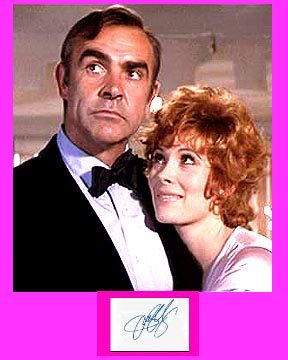
|

|

|
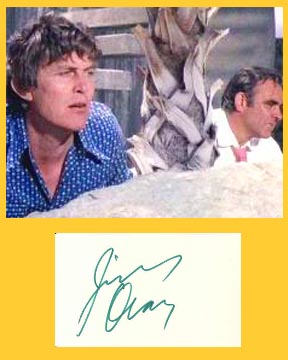
|
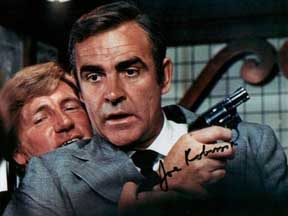
|

|

|

|
Despite Eon Productions ongoing 'Spin Control' to downplay the impact, the failure of ON HER MAJESTY'S SECRET SERVICE was a crushing blow for producers Albert Broccoli and Harry Saltzman. Despite Richard Maibaum's literate script (the last to attempt fidelity to a Fleming novel, until 2006's CASINO ROYALE), first-time director Peter Hunt's remarkable 'vision', and a performance by novice actor George Lazenby that wasn't nearly as bad as some reviewers at the time would claim, OHMSS was spurned by many Bond fans, and had some critics proclaiming "Tracy Was Killed, but Bond Is Dead".
While American actor (and future Ambassador to Mexico) John Gavin had already signed on play 007 in DIAMONDS ARE FOREVER (George Lazenby's inflated ego had gotten the better of him, and he'd either 'quit' or managed to get himself 'fired'), Broccoli, always opposed to an American as James Bond, decided that what the franchise needed was a major overhaul. Gavin was dropped, Peter Hunt was dropped, and Richard Maibaum's revenge-driven Bond script was discarded, rewritten by Tom Mankiewicz into a light-hearted, witty send-up of the earlier 007 films, ignoring his wife's death, and concentrating on gadgets, sex, and superhuman heroics, as Bond investigated a diamond-smuggling ring with a nefarious purpose, controlled by Ernst Stavro Blofeld (who Bond supposedly killed in the pre-credits sequence). Veteran director Guy Hamilton, who had guided GOLDFINGER, everyone's favorite Bond movie, was brought back to direct the project...and Broccoli, bowing to pressure from the 007 audience, approached Sean Connery to take the role, one more time.
Connery, now 40, had made four films since his last Bond outing, YOU ONLY LIVE TWICE, and he disliked Broccoli (feeling the producer had 'robbed' him of his share of the profits for the first two Bond films), so he loved the leverage he now possessed. When asked about the size of his paycheck to resume the role, he joked, "I always wanted to own a golf course and a bank...I already own a golf course..." He also stipulated a hefty fee for each day the production ran over schedule (Lest he seem TOO greedy, much of his salary went to Scottish charities). As a final insult, the actor refused to get into shape for filming, appearing paunchier and grayer than ever (making Broccoli so irate that when he hired Roger Moore for the follow-up, LIVE AND LET DIE, he ordered him, immediately, to "lose weight and get a haircut!")
Broccoli's instincts on the direction of the Bond franchise proved correct, as the comedy-oriented DIAMONDS ARE FOREVER would become one of 1971's biggest hits. Connery tossed off one-liners with ease (even joking, tongue in cheek, about his 'vacation' from the role); Jill St. John, 30, 'channeled' Lucille Ball as klutzy, wardrobe-optional 'Tiffany Case'; Lana Wood (younger sister of Natalie), 25, the film's 'sacrificial lamb', 'Plenty O'Toole', barely kept her heaving, monumental cleavage in check; country singer/entrepreneur Jimmy Dean, 42, drawled his way through a "southern-fried" variation of Howard Hughes, with screen legend, Bruce Cabot, 67 (in his last film), as Dean's 'right-hand man', Bert Saxby; and 41-year-old Charles Gray, whose 'take' on Ernst Blofeld would be witty and sexually ambiguous rather than dark and threatening (with two henchmen, Mr. Wint and Mr. Kidd, who would be gay, as well, and so broadly caricatured that the homosexual community would justifiably protest the film). With a 'Moon Buggy' chase across the Nevada desert and a nighttime car chase/demolition sequence through the neon-lit streets of downtown Las Vegas, fistfights (the most memorable being between the aging Bond and two young female acrobats named 'Bambi' and 'Thumper'), explosions and gadgets, galore, Bond 'purists' were appalled at the silliness, but a successful new 'formula' had been created, which would serve Roger Moore very well during his long tenure as 007.
And Sean Connery could "buy his bank"...

|

|

|
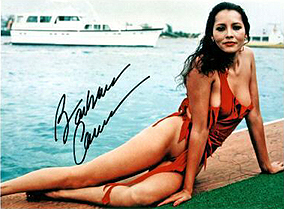
|

|

|

|

|
When Alec McCowen, in a brief cameo as 'Algernon' (Q), welcomes Sean Connery back to 'active service' in NEVER SAY NEVER AGAIN, with the fervent hope that he'd see the return of some "gratuitous sex and violence", he echoed the hopes of many 007 fans, who felt Roger Moore's often comic 'take' of the secret agent over the previous 10 years had lost the 'dangerous' edge that had made the best of Connery's films so memorable. It had taken nearly twenty years to bring all the pieces into place for the non-franchise 'Bond' film to be made, and while Moore's OCTOPUSSY would out-gross the 'upstart' (thanks to MGM's heavy marketing), NEVER SAY NEVER AGAIN would prove that Connery was STILL a James Bond to reckon with!
When Albert Broccoli and Harry Saltzman bought the rights to Ian Fleming's 'James Bond' collection, they assumed that the only novel not in the 'package' was "Casino Royale", the first Bond novel Fleming wrote, which had already been sold (and would eventually end up in the hands of Charles K. Feldman, who would film it, as a Bond parody, in 1967). But they were unaware of the convoluted history behind "Thunderball"; while the novel they purchased was written by Fleming, he neglected to mention that it had been based on an earlier unproduced screenplay he had written, with Kevin McClory and Jack Whittingham. Justifiably angry that they had been 'left out', the two writers took Ian Fleming and his estate, and Eon Productions to court, and won, gaining them 'co-author' credits and a share of the motion picture THUNDERBALL's profits, as well as, to a limited extent, approval to use the character of "James Bond" for independent film projects.
It became Kevin McClory's obsession to produce his own 'Bond' film, and he recruited spy novelist Len Deighton and Sean Connery (harboring a long-time grudge against Albert Broccoli over his own Bond profits) to help create the perfect vehicle. The screenplay they wrote, "Warhead", was a wild, futuristic 007 adventure, with Connery as Bond, and Orson Welles as the villain. But MGM/UA took McClory back to court, and after a long litigation, it was determined that he only had rights to use the elements of THUNDERBALL for any film he'd choose to make (which was why you would never see SPECTRE or Ernst Blofeld mentioned in an Eon 'Bond' film after the early seventies...Broccoli did not want McClory demanding any share of the profits).
Limited to, essentially, a remake, McClory and Connery put everything into it they could, expanding on a film that, when initially released, was criticized for being overlong. The end result was a mixed bag; Connery, at 52, in FAR better shape than he'd been in DIAMONDS ARE FOREVER, looks fabulous as the older Bond and handles the humor, fights, and love scenes with panache; Barbara Carrera, 31, makes a campy femme fatale; Kim Basinger, 29, is pretty, if wooden, as an American version of 'Domino'; and there are wonderful cameos, by Max von Sydow, Edward Fox, Bernie Casey, Rowan Atkinson, and many others. On the down side, the underwater sequences are too long and confusing; Klaus Maria Brandauer, 39, as 'Maximilian Largo', is more petulant than menacing; Michel Legrand's music is annoying, at best; and Irvin Kershner's direction tends to drag. And with a budget pushed to the limit (Connery himself invested in the project to keep it going), the film could not be marketed competitively against OCTOPUSSY, with all of MGM's resources behind it.
Still, the film, with it's 'in' joke title (Connery had answered all press questions about playing Bond, after DIAMONDS ARE FOREVER, "Never again!"), would be successful, and encourage Sony Pictures, twenty years later, to take MGM to court to produce a 'Bond' film of their own...and, after losing the case, they would BUY MGM, and get Bond, ANYWAY!
After forty years, James Bond is still a hot property!
As for Sean Connery, post-'Bond'...What can be said, that hasn't, already? A bonafide screen 'legend' and Academy Award winner (for THE UNTOUCHABLES, 1987), recipient of the 2006 AFI Lifetime Achievement Award, voted "Sexiest Man Alive" at age 59 in a 1989 'People' Magazine poll, heralded by the international press as the world's greatest film star, unflagging supporter of his native Scotland, it's charitable causes, and fight for independence, Connery was knighted by Queen Elizabeth in 1999...
Having 'made peace' with Eon Productions, the actor succeeded so spectacularly in not being 'type-cast' as James Bond that he served as an inspiration to every subsequent 'Bond', as well as to actors in other long-running film series (such as Christopher Reeve and Harrison Ford)...One of the world's most sought-after stars, until he announced his retirement from the screen, in 2006, he was Peter Jackson's first choice to play Gandalf in "The Lord of the Rings" (which he declined, not wishing to spend sixteen months on location in New Zealand). Despite some recent health problems, Sir Sean remains the most beloved of all 007 actors, to this day, with a truly wonderful Official Website, where you can 'catch up' on his latest activities!

|
Next: GEORGE LAZENBY






This site is for entertainment purposes, only, and all opinions expressed are solely my own, and do not represent any parties affiliated with either the official James Bond franchises, or the estate of Ian Fleming.
James Bond copyrights held by respective owners: EON Productions Ltd, Danjaq LLC, Sony Corporation, MGM, Ian Fleming Publications Ltd, etc.
Send e-mail to the Webmaster
with any questions or comments about this site.

|
 |
 |